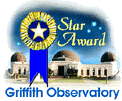
|
|
|
The Planets this Month:To find out more about the planets, click on an image, below, and to find out about the constellations the planets pass through, click on the blue links. |
Times in UTC | |

|
Mercury:
The Winged Messenger of the Gods
|
Rises 02:57
Sets 18:51 Phase 22% |

|
Venus:
The Goddess of Love
|
Rises 07:48
Sets 21:41 Phase 25% |

|
Mars:
The God of War
|
Rises 00:03
Sets 14:54 Phase 87% |

|
Jupiter:
The Bringer of Jollity.
|
Rises 17:14
Sets 01:16 Phase 100% |

|
Saturn:
The Bringer of Old Age
Saturn's rings are still a fine site in telescopes, although now not fully open. Several of Saturn's moons including the largest, Titan, can easily be seen in a small telescope. |
Rises 07:01
Sets 21:48 Phase 100% |
|
|
Uranus:
The Magician
|
Rises 22:19
Sets 09:33 Phase 100% |




